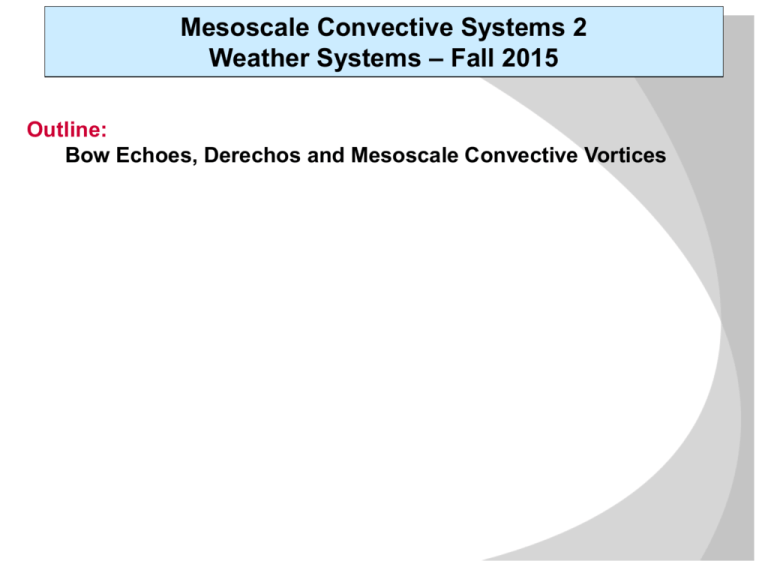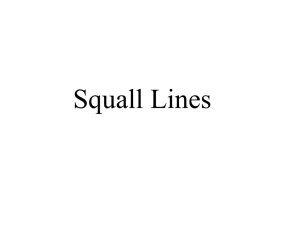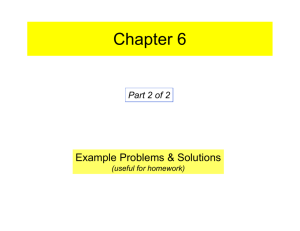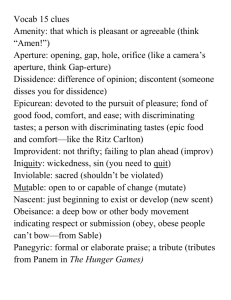lecture17_mcs2
advertisement

Mesoscale Convective Systems 2 Weather Systems – Fall 2015 Outline: Bow Echoes, Derechos and Mesoscale Convective Vortices Previously … We looked at the effects that cold pools and vertical wind shear can have on the tilt, intensity, and structure of squall lines We also examined the various organizational structures of observed MCSs Today: Bow echoes Mesoscale convective vortices Convection as a function of shear and CAPE Bulk Richardson No. Rasmussen and Wilhelmson, 1983 From last time: rear-inflow jet Real squall lines are not simply 2D; and the cold pool and rear inflow jet tend to be strongest near the center of the line This can cause the line to “bow”, creating what’s called a “bow echo” Bow echoes Wakimoto et al. 2006 Adapted from Fujita (1978) Bow echoes Bow echoes are often associated with severe winds at the surface This can happen both from the descending RIJ, as well as from smaller-scale mesovortices They typically have “bookend vortices” – a cyclonic vortex on the north end of the bow, and anticyclonic on the south end Bookend vortices Klemp (1987) Updraft tilts ambient horizontal vorticity into the vertical and stretches it; downdrafts tilt those vortex lines downward, creating the bookend vortices The northern one tends to become dominant, because of Coriolis effects 3 June 2003 Omaha Bow Echo Observed during BAMEX field program Produced damaging winds exceeding F1 intensity Wakimoto et al. 2006 3 June 2003 Omaha Bow Echo Extensive region of large CAPE Significant warm moist advection Presence of an upper-level shortwave Wakimoto et al. 2006 Smaller-scale “mesovortices” Red & purple = damage path Black dashed = vorticity Wakimoto et al. (2006) 8 May 2009 Radar reflectivity (Springfield, MO, 1235 UTC) Storm relative velocity Derecho Sometimes a bow echo (or series of bow echo) causes a derecho: a widespread severe windstorm Although a derecho can produce destruction similar to that of tornadoes, the damage typically is directed in one direction along a relatively straight swath By definition, if the wind damage swath extends more than 240 miles (about 400 kilometers) and includes wind gusts of at least 58 mph (93 km/h) or greater along most of its length, then the event may be classified as a derecho June 29, 2012 Source: http://earthsky.org/earth/videos-and-imagesviolent-us-storm-of-june-29-2012 Derecho 8 May 2009 “superderecho”: http://www.spc.noaa.gov/misc/AbtDerechos/casepages/may8200 9page.htm Derecho 29 June 2012: Radar and Images http://vielmetti.typepa d.com/vacuum/2012/0 6/derecho-of-june-292012.html Sterling, VA 00 UTC 30 June sounding Mesoscale convective vortices (MCVs) Sometimes, the northern bookend vortex is observed to grow into a mesoscale convective vortex (MCV), which lasts long after the parent MCS decays Source: http://lukemweather.blogspot.com/2011/07/mesoscale-convective-vortex-mcv.html PV thinking for MCSs We can consider MCSs in terms of potential vorticity However, for mesoscale motions, the traditional balance constraints (QG, SG, etc.) don’t apply Need to use different balance condition: often nonlinear balance is used Otherwise, “PV thinking” progresses similarly… PV The prognostic equation for potential vorticity q can be written as: This says that if we neglect diabatic heating and friction, PV is conserved Also note that the RHS is written as the divergence of a vector PV If we take the volume integral between two isentropic surfaces, and use the divergence theorem, we obtain the following: d dt òò ò rq dx dy dz = 0 V This states that PV between isentropic surfaces cannot be created or destroyed (unless the isentropic surface intersects the surface) We can think of the PV between isentropes as a “substance” – the amount of PV in that volume doesn’t change This is true even with diabatic and frictional effects included! PV However, diabatic heating/cooling can move mass across isentropes θ+2Δθ θ Constant amount of “PV substance” θ-2Δθ PV However, diabatic heating/cooling can move mass across isentropes θ+2Δθ . θ Constant amount of “PV substance” θ θ-2Δθ PV However, diabatic heating/cooling can move mass across isentropes θ+2Δθ More mass W Less mass θ θ-2Δθ PV However, diabatic heating/cooling can move mass across isentropes θ+2Δθ W Constant amount of “PV substance” θ θ-2Δθ PV However, diabatic heating/cooling can move mass across isentropes θ+2Δθ W Constant amount of “PV substance” θ θ-2Δθ Same amount of “PV substance” between isentropes, but now there’s less mass there – the PV is more concentrated PV When diabatic heating increases with height, PV will increase; when it decreases with height, PV will decrease θ+2Δθ PV diluted W PV concentrated θ θ-2Δθ PV in a mature MCS Can approximate this effect as: dq ( f ) dt z - PV - PV + PV + PV - PV Relevance of MCVs Some MCVs last several days An MCV in shear creates lifting (and destabilization) on the downshear side This lifting in some cases leads to the development of a new MCS From Trier et al. (2000), after Raymond and Jiang (1990) Consider the case of a strong low-level jet approaching the MCV: the downshear side is the same side with the high θe (unstable) air Parcels are lifted above their LFC; a new MCS ensues—these situations often lead to heavy rain/flash flood events Fritsch et al. (1994) Typical MCV tracks MCV movelment closely approximated by the mid-tropospheric flow Trier et al. (2000) Will convection develop near the MCV on the 2nd (or 3rd) diurnal cycle? There was less ambient shear and more CAPE in MCV cases that led to a secondary MCS than in cases where no secondary convection occurred Trier et al. (2000) Precipitation episodes Carbone et al. (2002) identified “episodes” of precipitation in the US that last several days They suggest that identifying the mechanisms responsible can improve prediction of warm-season precipitation




